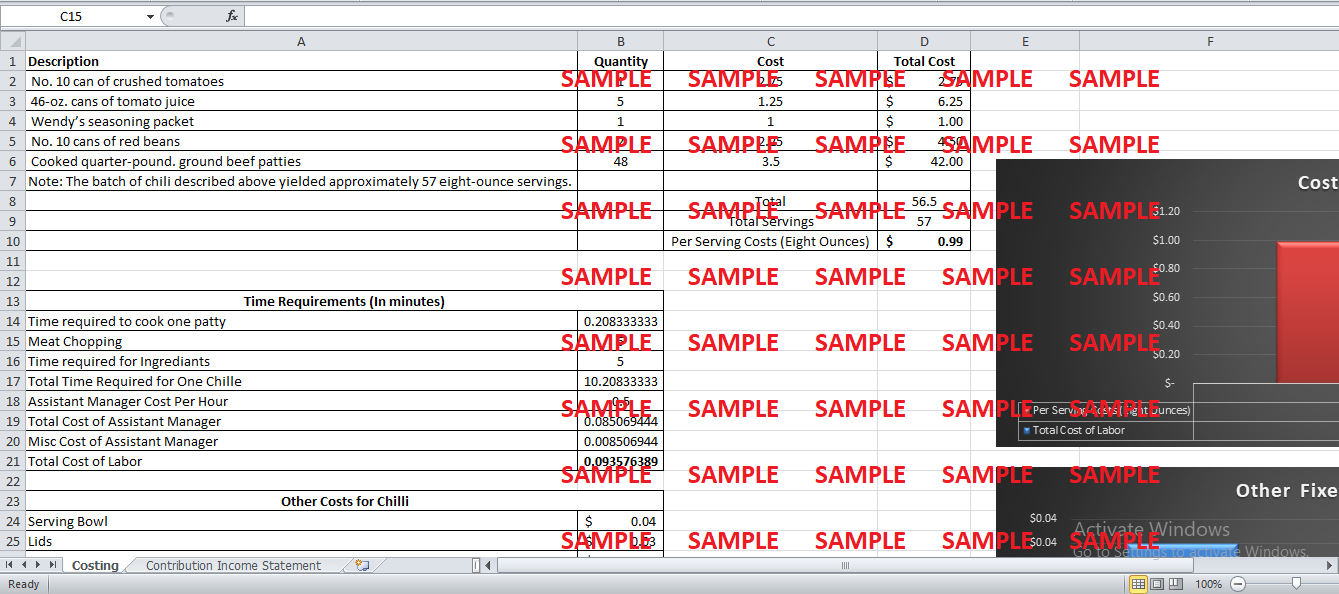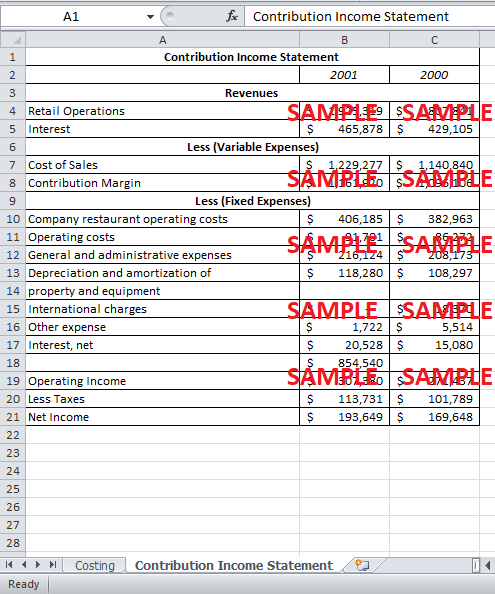Get instant access to this case solution for only $19
Wendy's Chili A Costing Conundrum Case Solution
As a matter of fact, it is quite true that Wendy’s hamburger was special from numerous perspectives. Firstly, it is also crucial to mention that one prime reason for the success of this burger might be rooted in the fact that Wendy was at its initial stage of operations. Additionally, various features of hamburger and the ‘special menu’ also made this hamburger a success. Firstly, Wendy distinguished itself from the competitors by offering an ‘old fashion’ burger. The burger was ‘square’ in its shape. At its initial stages, the major competitors of Wendy included McDonald's, Burger King and Hardees. None of the competitors shared this feature of burger shape. Moreover, this special square-shaped burger was served fresh. The burger was only made to order, and customers could see it's grilling and baking. This feature made customers comfortable with what they were eating. Additionally, these ‘hot n’ juicy’ hamburgers could be customized in accordance with the needs of the individual customers. This feature of the serving gave a huge exclusive competitive advantage to Wendy. Also, another successful strategy implemented by Wendy was the key to its hamburger success. Wendy shortened their menu to only four items, but the individual customizations allowed for 256 possible combinations. Also, other competitors offered some sort of soft drink with the hamburger servings. On the contrary, Wendy was also distinctive in its choice for a side menu item. Wendy offered only one side menu known as ‘frosty’. Technically it was dessert but, customers preferred it to be served with the hamburgers. This unique combination also allowed Wendy to capitalize on its hamburger sales. In short, the success of the hamburgers was embedded in the ‘uniqueness’ of the business operations of Wendy.
Following questions are answered in this case study solution
-
How was Wendy’s able to achieve its initial success and to grow so rapidly at a time when the quick-service hamburger business appeared to be saturated?
-
What benefits might have resulted from Wendy’s’ “limited menu” concept? What were the disadvantages of such a concept? Why the concept was eventually discontinued?
-
Why was Wendy’s’ drive-through window successful when other quick-service restaurant chains had been unsuccessful at implementing the same concept?
-
How much does a bowl of chili cost on a full-cost basis? An out-of-pocket basis?
-
For determining the true profitability of chili, how much does a bowl of chili really cost?
-
Would you recommend dropping chili from the menu? Why or why not?
Case Analysis for Wendy's Chili A Costing Conundrum
2. What benefits might have resulted from Wendy’s’ “limited menu” concept? What were the disadvantages of such a concept? Why the concept was eventually discontinued?
The concept of a limited menu originated in the early phase of the development. At that time, there was a need for Wendy to develop a hardcore business strategy which should be consistent with the nature of their business. The potential benefits and disadvantages of the limited menu concept are listed below.
Benefits
-
Wendy’s business model focused on serving freshly cooked food. If the menu was large and diversified, then it could have been very difficult for Wendy to serve such a multitude of items under the banner of ‘fresh’ and ‘hot n’ juicy’. This is because fresh cooking requires accurate demand forecasting and a trained workforce. In the case of a large menu, the banner of ‘freshness’ was going to be compromised. Also, the benefits of cost savings and efficient time allocation also arose.
-
Additionally, in a saturated market, as a new entrant, Wendy has to creative enough so that it could be recognized as a separate or ‘innovative’ entity. The idea of a limited menu enhanced Wendy’s ability to market effectively itself under the banner of ‘uniqueness’. Hence, the advertising ability of Wendy has augmented its popularity.
-
However, the biggest advantage came in the notion that no other competitor was offering such a menu at that time. Again, the exclusivity of the business operation was boosted.
Disadvantages
-
Wendy’s limited menu didn’t take into account the concept of a family meal. Even though the menu offered 256 combinations, there were only four basic items. It is a common issue that families prefer to go to places where they can find the menu which is diversified enough to cater to the needs of all the family members, including the kids. Especially, kids are very choosy in their choices. The limited menu restricted the ability of Wendy to market itself to the families.
-
With the notion of a limited menu, Wendy was unable to target the market of its leading competitors. This allowed them to gain a slow but progressive competitive edge over Wendy. This meant that, in the due course of progress, Wendy was not trying to clinch the market share of its leading competitors. The only increase in market share can be attributed to its unique offerings.
-
One of the biggest disadvantages constitutes the fact that no core menu item was served to the vegetarian’ customers.
At a later stage of the life of Wendy, it has to remove the limited menu item because it was unable to grab additional market share and, various other new entrants copied this concept (in a different fashion). Also, in the latter half of the 1970s, customer demands also altered which forced Wendy to enter the market in the traditional style.
3. Why was Wendy’s’ drive-through window successful when other quick-service restaurant chains had been unsuccessful at implementing the same concept?
The success of the drive through window of Wendy was amazing and, the biggest credit for this success goes to the business acumen of the originators of this idea. It is true that Wendy initiated the drive through window at a time when most of its competitors lacked this capability. Hence, the credit of the initiation of the idea of drive through can be attributed exclusively to Wendy. This attribute of primitiveness provided Wendy with a huge competitive advantage. The drive-through window of Wendy was the first-ever organized drive through for any fast food restaurant. In the future, its leading competitors initiated the same concept. However, the drive through window of Wendy retained its reputation and business because it was the ‘originator’ of this concept. Another reason for the success of the drive through window of Wendy can be attributed to the fact that, when its competitors copied the same idea, there was no uniqueness or individuality entailed with that concept. Consumers might not have realized the ingenuity for this new drive through windows.
4. How much does a bowl of chili cost on a full-cost basis? An out-of-pocket basis?
In order to analyze the true profitability of Chile, there is a need to break down its costs into smaller components. Let’s start with the cost of materials.
Cost of Materials
Cost of Materials includes the costs associated with the buying of the ‘raw material’. The following chart lists all the relevant prices of the required materials.
There are five distinct components in materials and all of them include the cooking ingredients. Tomato is required both in crushed and juice format. The combined costs of these materials are equal to $8.95. The seasoning packet of the product also costs around $1. Additionally, red beans are also required as part of the ingredients. Moreover, the most important and crucial component of the ingredients include the beef and burger patties for the hamburgers. For a standard buying, beef patties amounted to $42. It is clear that a major portion of the ingredients is composed of the cost to patties. The total costs amount to $56.6. From this cost base, a total of 57 eight ounces servings can be functioned. Therefore, the cost per burger amounted almost to $0.99.
Assistant Manager’s Costs
It is explicitly mentioned that, in the preparation of the child, only the assistant manager utilizes his/her time. Therefore, in the computation of the cost of labor costs, only the salary of assistant manager is relevant. The following graph shows the time requirements for the assistant manager.
The assistant manager dedicated 10.2 minutes catering to the three basic needs of the process; cooking of patty, meat chopping, and ingredient mixing. The per-hour salary of assistant manager amounts to $0.5. Hence, for serving a single chilled, the total labor costs incurred aggregate to $0.085. Additionally, the payroll taxes and other miscellaneous expenses amount to $0.0085. Hence, the total per chilled serving labor cost is equal to $0.09.
Miscellaneous Costs for Chille
In addition, the cost of ingredients and labor, there are also some miscellaneous costs incurred in the process.
Get instant access to this case solution for only $19
Get Instant Access to This Case Solution for Only $19
Standard Price
$25
Save $6 on your purchase
-$6
Amount to Pay
$19
Different Requirements? Order a Custom Solution
Calculate the Price
Related Case Solutions
Get More Out of This
Our essay writing services are the best in the world. If you are in search of a professional essay writer, place your order on our website.



